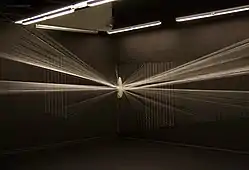Plastic art are art forms which involve physical manipulation of a plastic medium by molding or modeling such as sculpture or ceramics. Less often the term may be used broadly for all the visual arts (such as painting, sculpture, film and photography), as opposed to literature and music.[1] Materials for use in the plastic arts, in the narrower definition, include those that can be carved or shaped, such as stone or wood, concrete, glass, or metal.
The term "plastic" has been used to mean certain synthetic organic resins ever since they were invented, but the term "plastic arts" long preceded them. The term should not be confused, either, with Piet Mondrian's concept of "Neoplasticism".
History
The oldest known plastic arts date to (30,000–34,000 BP).[2]
Philosophy
In contrast to the limiting of 'plastic arts' to sculpture and architecture by Friedrich Wilhelm Joseph Schelling in 1807,[3] the German critic August Wilhelm Schlegel (1767–1845) applied the concept not only to visual arts, but also poetry.
Classical poetry lines he saw utilizing plastic isolation, and rhyme falling under the Romantic (domain).[4]
In Schlegel's Viennese lectures (1809–1811), published in 1827 as On the Theory and History of the Plastic Arts, he contrasted the plasticism of Classical Art with picturesque Romanticism. He
operated with the antinomy of terms plastic/pictorial, mechanically/ organically, finite/ infinite, and closed/accomplished. Schlegel stated that the spirit of the entire antique culture and poetry was plastic and that the spirit of modern culture, however, was picturesque (pittoresk)[5]
These distinctions were carried over into Russian Romanticism aesthetics
Venevitinov objected to the indiscriminate use of the term 'pictures'. In his use of August Schlegel's term 'plastic' (plastisch, plastika) he argues for a return to the simple, primitive, enclosed, defined, limited, finite, corporeal, and plastic world of the ancients. There seem to have been two interpretations of the plastic - picturesque contrast (antitheses) in Romantic Idealist philosophy. As Venevitinov uses the contrast, and as August Schlegel intended it to be used when he defined it in Lecture I of Vorlesungen über dramatische Kunst und Literatur, it denoted the difference between the corporeal mind of the man of antiquity and the 'picturesque' mind of modern man. Ancient art appeals directly to the senses, modern art gives rise to mental pictures or images. The former is therefore real and corporeal, the latter ideal.[6]
Gallery

 Saytour Torchons Nîmes
Saytour Torchons Nîmes Sarabande Musée des Tissus Lyon 2007-2008
Sarabande Musée des Tissus Lyon 2007-2008 Milton Becerra Ale'ya Durban Segnini Gallery Miami 2009.
Milton Becerra Ale'ya Durban Segnini Gallery Miami 2009. La Ferté Bernard Festival Artec 2010
La Ferté Bernard Festival Artec 2010 Bois de Belle Rivière Québec 2010
Bois de Belle Rivière Québec 2010 MasterCard/Visa (If it wasn't for plastic money I wouldn't have any money at all) Tyler Turkle, 2006, Poured Acrylic, 54 × 43 inches
MasterCard/Visa (If it wasn't for plastic money I wouldn't have any money at all) Tyler Turkle, 2006, Poured Acrylic, 54 × 43 inches
See also
- Art materials – Materials and tools used to create a work of art
- Handicraft – Item production made completely by hand or with simple tools
- Media (arts) – Materials and tools used to create a work of art
- Plastic in art – Use of synthetic materials to create art
- Visual arts – Art forms that create works that are primarily visual in nature
References
- ↑ "Merriam-Webster Online (entry for "plastic arts")". Merriam-webster.com. Retrieved 2011-10-30.
- ↑ Witzel, E. J. Michael (2012). The Origins of the World's Mythologies. Oxford University Press. p. 260. ISBN 9780199710157.
Apart from rock art, whether engraved, drawn, or painted, there also exist some examples of early sculptures and plastic art (30,000–34,000 bp )
- ↑ Russian Romantic Criticism: An Anthology, edited by Lauren Gray Leighton, Published by Greenwood Publishing Group, 1987, ISBN 0313255849, ISBN 978-0313255847
- ↑ The literary theories of August Wilhelm Schlegel by Ralph W. Ewton jnr, Published by Walter de Gruyter and Co (1972), ISBN 3110991632, ISBN 978-3110991635
- ↑ Civic Art Then and Now: The Culture of Good Place-making by Charles C. Bohl, in Sitte, Hegemann and the Metropolis: Modern Civic Art and International Exchanges, edited by Charles Bohl and Jean-François Lejeune, Published by Routledge, 2009, ISBN 0415424070, ISBN 978-0415424073
- ↑ Russian Romantic Criticism: An Anthology, edited by Lauren Gray Leighton, Published by Greenwood Publishing Group, 1987, ISBN 0313255849, ISBN 978-0313255847
Further reading
- Barnes, A. C., The Art in Painting, 3rd ed., 1937, Harcourt, Brace & World, Inc., NY. OCLC 1572753
- Bukumirovic, D. (1998). Maga Magazinovic. Biblioteka Fatalne srpkinje knj. br. 4. Beograd: Narodna knj.
- Fazenda, M. J. (1997). Between the pictorial and the expression of ideas: the plastic arts and literature in the dance of Paula Massano. N.p.
- Gerón, C. (2000). Enciclopedia de las artes plásticas dominicanas: 1844–2000. 4th ed. Dominican Republic s.n.
- Schlegel, August Wilhelm., (1966) Vorlesungen uber dramatische Kunst und Literatur, Stuttgart: Kohlhammer Verlag, 1966, p. 21f.
External links
 Media related to Plastic arts at Wikimedia Commons
Media related to Plastic arts at Wikimedia Commons